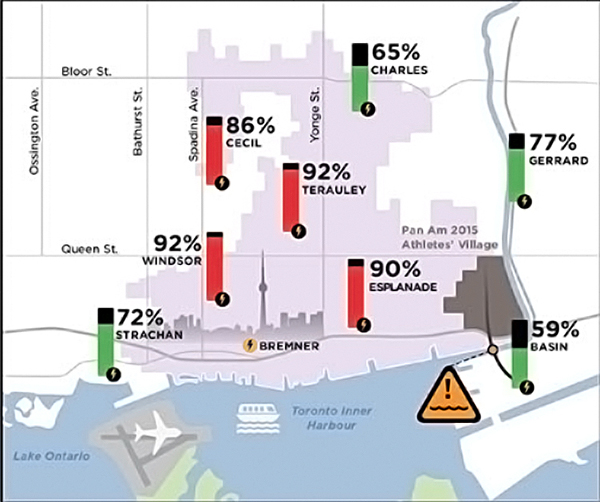With Toronto's current building boom in full swing, Toronto has more skyscrapers and high-rise buildings under construction than any North American city, Toronto Hydro noted in an essay released to news agencies April 2. Electrical connection requests for these buildings to Toronto Hydro-Electric System have increased by approximately 58 per cent from 2009 levels, and by approximately 127 per cent from 2003, Toronto Hydro says. Initial results from the 2011 census show that some pockets of downtown Toronto have seen unprecedented population growth, confirming that the city is going vertical.
In fact, Toronto has close to 200 new buildings or projects expected in 2012. New York is second to Toronto with 96 skyscrapers currently underway or planned. Toronto's downtown core is seeing increased commercial growth through new hotel developments like the Trump Tower, and hospital expansions like CAMH and Sick Kids. The Sick Kids project not only requires designated electrical cables (previously, one cable could service two to three commercial customers), but will also add over 12 megawatts of new demand when it comes fully on-line this year. To put this into context, the city of Kenora's average demand is 18MW. In 2011, Toronto Hydro's new additional load was estimated at 100MW and the utility expects the same for 2012.
 The challenge is to connect these buildings to the local grid and supply the electrical demand on time, per customers' schedules. In many areas of Toronto, existing cables and underground equipment are already 50-70 years old. Comparing this scenario to a home, it would be like adding a brand new kitchen with modern appliances to a 'knob and tube' electrical system. As it stands, approximately 29 per cent of Toronto Hydro's infrastructure is already past its projected life expectancy.
The challenge is to connect these buildings to the local grid and supply the electrical demand on time, per customers' schedules. In many areas of Toronto, existing cables and underground equipment are already 50-70 years old. Comparing this scenario to a home, it would be like adding a brand new kitchen with modern appliances to a 'knob and tube' electrical system. As it stands, approximately 29 per cent of Toronto Hydro's infrastructure is already past its projected life expectancy.
Several of Toronto's downtown power stations built in the 1950's — such as Esplanade and Windsor Stations, serving most of the south west and south central parts of downtown — are already close to full capacity.
To accommodate and connect new projects like the Pan Am Games Athlete's Village, designers and engineers must determine which station will be able to supply this new development and determine the path for electrical cables. In certain cases, new civil infrastructure is required to create alternative paths for cables to reach connection points, as the existing infrastructure consisting of 75-year-old "clay tile ducts" has collapsed in many places under the pressure and stresses of modern roadway traffic. In the case of the Athletes Village, the supply will be provided from Basin Station in the Portlands neighbourhood (approximately 2 kilometres away) since stations that are closer to the Village are unable to handle the new electrical demand.
Work already underway on the Pan Am project has been challenging. In addition to new civil infrastructure, crews will need to take power cables from Basin Station across the waterfront and Lakeshore Avenue, over existing roadway bridges, and North to the site on Cherry Street. In this neighbourhood, cable is frequently submersed under water, with crews pumping cable chambers on a regular basis.
There are plans for more Waterfront beautification and condo developments in the Queen's Quay/East Bayside area, and further condo development across the southern end and east side of the city. The East Bayside revitalization is expected to add more than 60MW of new demand alone. To help alleviate the load on existing stations, provide spare capacity for emergency work or maintenance, and help meet the needs of the ever-changing city, a new station is needed.
Toronto Hydro's proposed Bremner station, located adjacent to the Roundhouse on Bremner Boulevard, is part of the solution. This station is planned to provide service to an important residential, entertainment and tourist area of the city. It would also allow Toronto Hydro to replace obsolete equipment at Windsor Station by providing load relief and an alternate supply to customers during emergencies and planned maintenance outages, ultimately helping to improve reliability. It would be a key investment, needed to service both existing and new customers downtown, and would be the first significant new station built in downtown Toronto since the 1950's.
